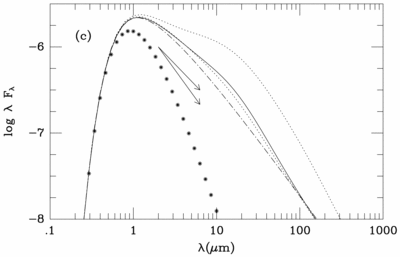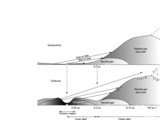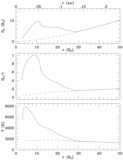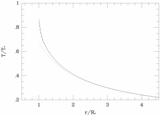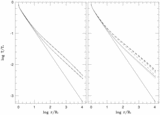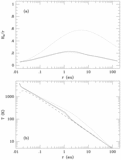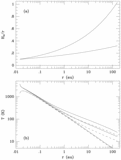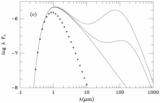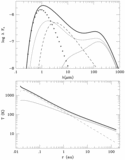Image Details
Caption: Fig. 6.
Reprocessing in active, low‐mass flux disks with decreasing curvature; ﹩\dot{M}=10^{-7}\,M_{\odot }\,\mathrm{yr}\,^{-1}﹩; a stellar source with ﹩R_{*}=3﹩ ﹩R_{\odot }﹩ and ﹩T_{*}=4000﹩ K is included. Solid lines represent models with disk shape defined by Rosseland‐mean photospheres of detailed vertical structure calculations. Dotted lines represent models with arbitrarily defined decreasing curvature such that ﹩z=1.9( r/ R_{*}) ^{0.05}﹩ (upper line) and ﹩z=1.65( r/ R_{*}) ^{0.05}﹩ (lower: designed to mimic the detailed model). (a) Relative disk thickness. All models increase in ﹩H_{d}﹩ throughout the radial range plotted. (b) Temperature profiles. The dashed line is the initial temperature distribution (﹩T_{\mathrm{init}\,}=T_{\mathrm{acc}\,}﹩). (c) Spectral energy distributions. Asterisks indicate the stellar contribution. The dot‐dashed line represents the results of a stellar reprocessing calculation carried out for a flat, active disk with ﹩\dot{M}=10^{-7}\,M_{\odot }\,\mathrm{yr}\,^{-1}﹩ with a stellar source (no disk‐to‐disk reprocessing). Vectors indicate slopes of ﹩a=-1﹩ and ﹩-4/ 3﹩. For the disks that flare with decreasing curvature, reprocessing is strong out to the peak in ﹩H_{d}/ r﹩ and decreases thereafter (note break between 10 and 30 μm). Spectra are essentially power law between 2 and 20 μm with a slope similar to what is observed for T Tauri systems.
Copyright and Terms & Conditions
© 1999. The American Astronomical Society. All rights reserved. Printed in U.S.A.


